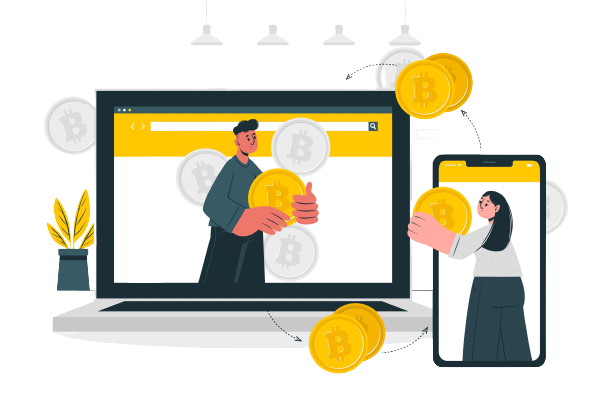
DeFi lending, short for “Decentralized Finance lending,” refers to the practice of lending and borrowing digital assets within decentralized financial ecosystems. Unlike traditional financial systems, DeFi lending operates on blockchain networks, utilizing smart contracts to facilitate lending transactions without intermediaries.
Importance Of DeFi Lending In The Financial Ecosystem
DeFi lending plays a pivotal role in reshaping the financial landscape by democratizing access to financial services. It enables individuals across the globe to participate in lending and borrowing activities without relying on traditional financial institutions. This inclusivity is particularly valuable for populations that are unbanked or underbanked, as they gain access to credit and interest-earning opportunities.
Additionally, DeFi lending introduces new dynamics to the traditional banking model. Users can act as both borrowers and lenders, enhancing financial autonomy and enabling them to earn interest on their assets. Furthermore, the removal of intermediaries reduces costs and allows for more efficient lending processes.
Growth And Adoption Of DeFi Lending Platforms
The growth of DeFi lending has been exponential, with a multitude of lending platforms and protocols emerging within the decentralized finance ecosystem. This growth is fueled by the demand for borderless financial services, increased interest in digital assets, and the potential for earning substantial returns.
The adoption of DeFi lending platforms has been driven by the advantages they offer, such as higher interest rates for lenders and more flexible borrowing options for borrowers. Additionally, the composability of DeFi protocols allows for the integration of various services, contributing to the ecosystem’s overall expansion.
As DeFi lending platforms continue to mature, they attract both individual users and institutional investors seeking alternative investment opportunities and exposure to the burgeoning crypto space. However, this growth is also accompanied by challenges, including security concerns, regulatory considerations, and the need for sustainable lending models.
How DeFi Lending Works
A. Explanation of Decentralized Networks and Smart Contracts
DeFi lending operates within decentralized networks, primarily built on blockchain technology. Blockchain provides a transparent and immutable ledger that records all lending and borrowing transactions. Smart contracts, self-executing code residing on the blockchain, play a central role in DeFi lending. They define the terms of lending agreements, automating the process and removing the need for intermediaries.
Smart contracts ensure that loans are collateralized appropriately, interest rates are enforced, and repayments are executed as agreed upon. These contracts also manage liquidation processes if borrowers fail to maintain collateralization ratios.
B. Role of Blockchain Technology in DeFi Lending
Blockchain technology underpins DeFi lending by providing a secure and trustless infrastructure. Transactions are recorded on the blockchain in a transparent and tamper-proof manner. This transparency enhances accountability and reduces the potential for fraud.
Furthermore, blockchain’s decentralized nature eliminates the need for intermediaries like banks or credit agencies. This reduces costs, accelerates transaction processing, and extends financial services to individuals who might not have access to traditional banking.
C. Comparison with Traditional Lending Models
DeFi lending differs significantly from traditional lending models. In traditional lending, centralized financial institutions serve as intermediaries that assess creditworthiness, set interest rates, and facilitate transactions. This process often involves time-consuming paperwork, credit checks, and extensive documentation.

In contrast, DeFi lending relies on collateralization, where borrowers lock up digital assets as collateral for the loans they receive. This collateralization mitigates the need for credit checks and enables a wider range of individuals to participate, as borrowers’ credit history becomes less relevant. Additionally, DeFi lending platforms operate 24/7, allowing users to access loans and earn interest at any time, unlike traditional banking hours.
D. Overview of Liquidity Pools and Lending Protocols
DeFi lending platforms utilize liquidity pools and lending protocols to facilitate lending and borrowing activities. Liquidity pools are pools of assets supplied by users looking to earn interest or provide liquidity. These pools are used to fund loans and earn interest.
Lending protocols define the rules and mechanisms for borrowing and lending. They determine interest rates, collateral requirements, and repayment terms. Users interact with these protocol’s user interfaces or decentralized applications (dApps), allowing for seamless lending and borrowing experiences.
Types Of DeFi Lending
A. Overcollateralized LendingDefinition and Concept: Overcollateralized lending is a type of DeFi lending where borrowers are required to provide more collateral than the value of the loan they are borrowing. This excess collateral serves as a buffer to cover potential losses in case of price fluctuations. If the value of the collateral drops significantly, the lending protocol can liquidate the collateral to recover the loaned funds.
Examples of Platforms Using Overcollateralized Lending: Platforms like MakerDAO and Compound Finance implement overcollateralized lending. In MakerDAO’s system, users lock up more cryptocurrency as collateral than the value of the stablecoin (DAI) they generate, ensuring stability and security.
B. Undercollateralized Lending
Definition and Concept: Undercollateralized lending, also known as unsecured lending, involves providing loans without requiring collateral that matches or exceeds the loan amount. Instead, borrowers are evaluated based on their creditworthiness, reputation, and other factors. This model introduces higher risk for lenders, as there’s no direct collateral to liquidate in case of default.
Risks and Benefits Associated with Undercollateralized Lending: The primary benefit is increased accessibility, as borrowers without substantial collateral can access loans. However, this type of lending presents significant risk for lenders due to the potential for default. It requires advanced risk assessment mechanisms and potentially higher interest rates to compensate for the increased risk.
C. Flash Loans
Explanation of Flash Loans and Their Use Cases: Flash loans are a unique feature of DeFi lending where users can borrow funds without the need for collateral, as long as the borrowed amount is returned within the same transaction. This concept leverages the composability of DeFi protocols, allowing users to perform complex operations in a single atomic transaction.
Instances of Successful Flash Loan Utilization: Flash loans have been used for various purposes, including arbitrage opportunities, collateral swapping, and governance manipulation. One notable example is the “flash loan attack” on the bZx protocol in which an attacker exploited price manipulation to profit and repay the loan in the same transaction, revealing a vulnerability in the system.
Participants In DeFi Lending
A. Borrowers
Reasons for Borrowing in the DeFi Space: Borrowers engage in DeFi lending for various reasons, including obtaining liquidity without selling their underlying assets, leveraging their holdings for trading or investment purposes, and participating in yield farming strategies. DeFi platforms provide borrowers with an alternative to traditional financial institutions, offering more flexibility, accessibility, and often faster loan processing times.
How Loans are Secured and Processed: Loans in DeFi lending are secured through the use of collateral. Borrowers lock up a certain amount of cryptocurrency as collateral, which acts as security for the loan. The collateralization ratio, set by the lending protocol, ensures that the value of the collateral exceeds the borrowed amount. Smart contracts automatically manage the borrowing process, including collateral evaluation, loan issuance, and repayment. If borrowers fail to repay the loan or maintain the collateralization ratio, the collateral can be liquidated.
B. Lenders
Motivations for Providing Funds to the Lending Pools: Lenders participate in DeFi lending by providing funds to lending pools, primarily driven by the potential to earn interest on their assets. Lenders can generate passive income by lending out their crypto holdings, contributing to the liquidity of the platform, and helping borrowers access the funds they need. Additionally, some lenders might be motivated by supporting the growth of the DeFi ecosystem and its decentralized nature.
Earning Potential through Interest Rates and Rewards: Lenders earn interest on the assets they lend to the platforms. Interest rates vary based on factors such as supply and demand for specific assets, the risk profile of borrowers, and the lending protocol’s parameters. In some cases, lending platforms also issue governance tokens or rewards to lenders, offering additional incentives for participation.
C. Liquidity Providers
Role in Maintaining Liquidity for the Lending Platforms: Liquidity providers contribute assets to liquidity pools, ensuring that there are enough funds available for borrowers to access and lenders to provide loans. These liquidity pools enable smooth lending and borrowing operations and help to stabilize interest rates.

Yield Farming and Other Incentives for Liquidity Providers: Liquidity providers not only earn a share of the interest generated from loans but also often receive additional rewards. Yield farming involves strategically allocating funds to different liquidity pools to maximize returns. Many DeFi platforms distribute governance tokens or other tokens as incentives to liquidity providers, allowing them to participate in platform governance and earn rewards beyond interest rates.
Popular DeFi Lending Platforms
A. MakerDAO
Introduction and Features: MakerDAO is one of the pioneering DeFi lending platforms built on the Ethereum blockchain. It offers users the ability to generate a stablecoin called DAI by locking up collateral in the form of various cryptocurrencies, such as Ether (ETH). DAI is designed to maintain a 1:1 peg with the US Dollar through algorithmic mechanisms. MakerDAO’s platform is decentralized and governed by MKR token holders.
Stability Mechanism and Governance: MakerDAO’s stability mechanism involves the use of Collateralized Debt Positions (CDPs) to generate DAI. MKR tokens are used to participate in the governance of the platform. MKR token holders make important decisions, such as setting collateralization ratios and adjusting stability fees. In times of extreme market volatility, when collateral value falls below the required amount, MKR tokens are minted to cover the debt, helping maintain the stability of the DAI stablecoin.
B. Compound Finance
Overview of the Lending Protocol: Compound Finance is a decentralized lending platform that allows users to lend and borrow a variety of assets. It operates on Ethereum and other blockchains. Users can supply assets to the platform and earn interest, while borrowers can use their supplied collateral to borrow other assets. Interest rates are determined algorithmically based on supply and demand dynamics.
COMP Token and Governance Model: Compound’s governance token, COMP, enables token holders to propose and vote on changes to the protocol’s parameters. COMP holders can influence interest rates, supported assets, and other protocol adjustments. This governance model provides users with a direct say in the platform’s development and evolution.
C. Aave
Features of the Aave Lending Platform: Aave is a DeFi lending platform that offers a wide range of features, including both overcollateralized and flash loans. It introduces the concept of “aTokens,” which represent users’ deposits and accrue interest in real-time. Aave’s unique feature is the ability to switch between fixed and variable interest rate modes, giving users flexibility in managing their loans.
Flash Loans and Unique Lending Mechanisms: Aave is renowned for introducing flash loans to the DeFi space. Flash loans allow users to borrow assets without requiring collateral, as long as the borrowed funds are returned within the same transaction. This feature has enabled creative use cases such as arbitrage and complex trading strategies, while also highlighting the importance of risk management.
To Conclude
In summary, the functioning of DeFi lending involves leveraging decentralized networks, blockchain technology, and smart contracts to automate lending processes. This stands in contrast to traditional lending models, enabling more accessible and efficient lending and borrowing mechanisms. Liquidity pools and lending protocols serve as the backbone of DeFi lending platforms, enabling users to participate in a decentralized financial ecosystem.
DeFi lending encompasses various types, including overcollateralized lending, undercollateralized lending, and the innovative concept of flash loans. Each type has its own set of advantages, risks, and applications within the decentralized financial ecosystem. DeFi lending involves a diverse set of participants, including borrowers seeking liquidity, lenders looking to earn interest, and liquidity providers contributing to the overall functionality of the lending platforms. Each participant group plays a crucial role in the DeFi lending ecosystem, contributing to its growth and sustainability.